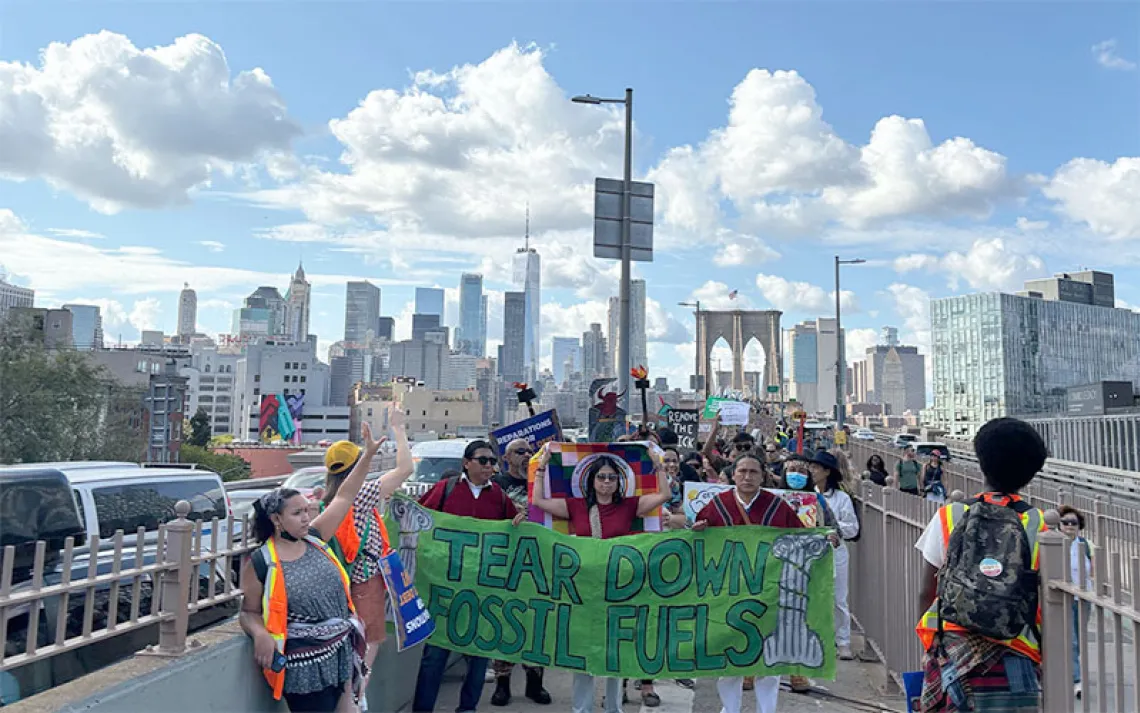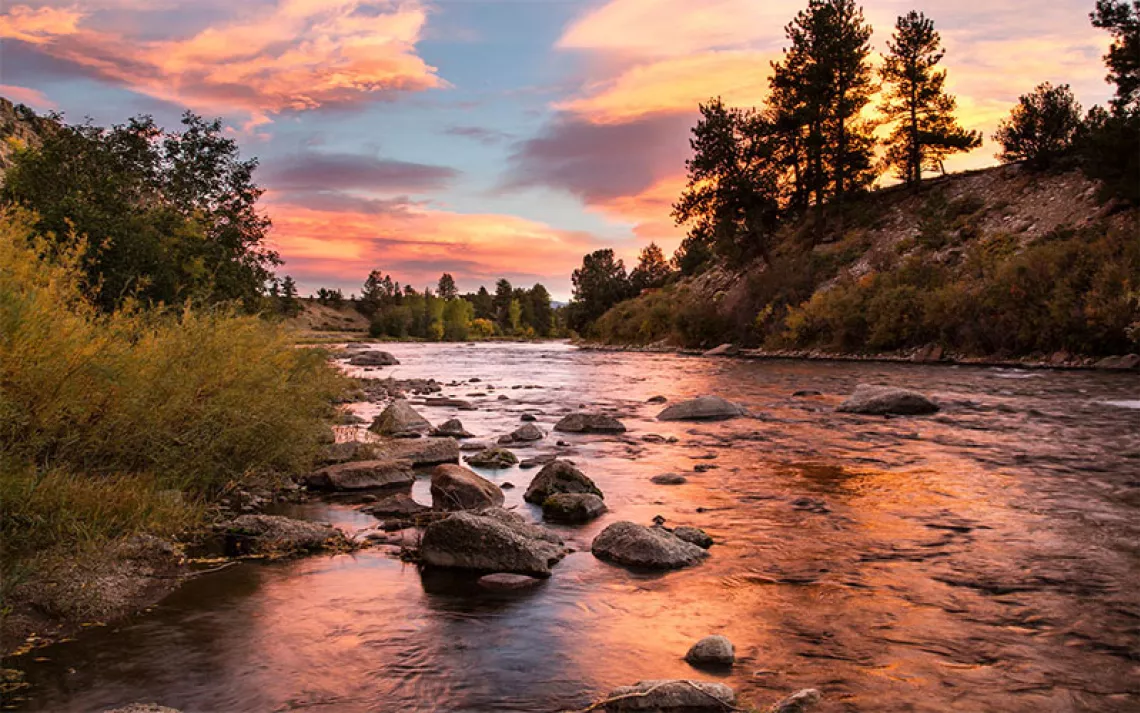Alaska's Incredible Shrinking Village
Rising seas are claiming Shishmaref and its Native culture of self-sufficiency
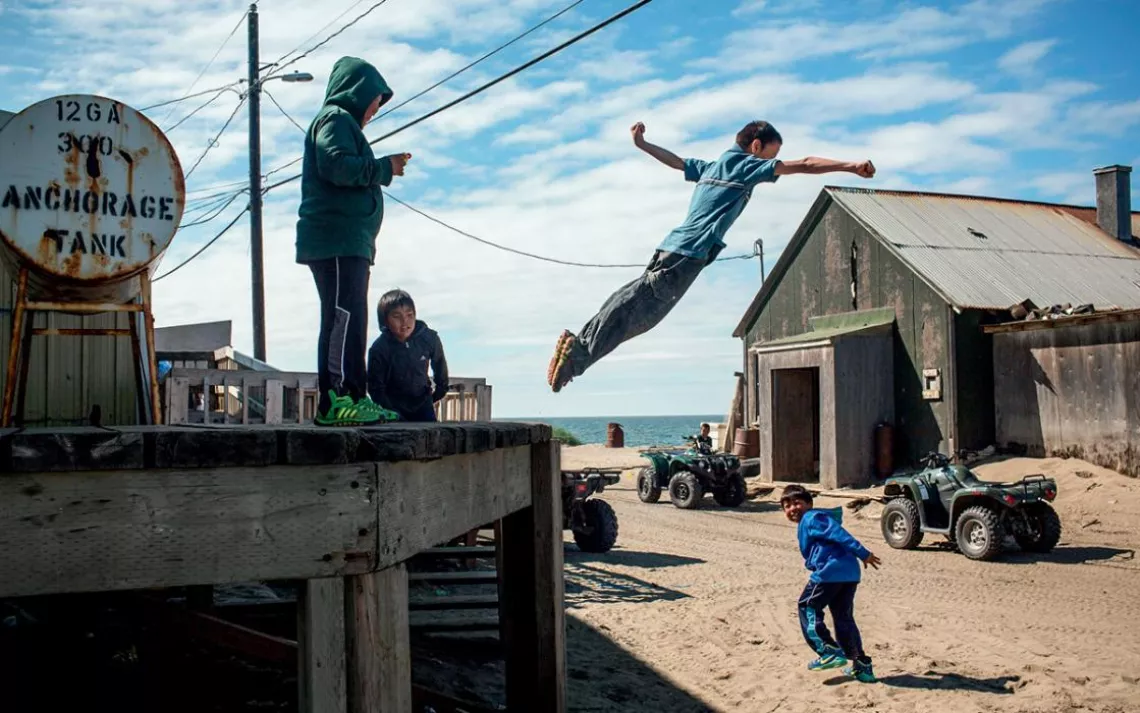
Inupiaq children play in Shishmaref, Alaska | Photo by Andrew Burton/Getty Images
IT'S FOUR DAYS before graduation, and 19-year-old Tammy Iyatunguk, a high school senior in Shishmaref, Alaska, is contemplating her future. She would like to be somewhere, she says, where she won't have to worry about the ground around her washing away.
Tammy's village sits on a tiny barrier island in the Chukchi Sea, off the northwest coast of Alaska, 20 miles below the Arctic Circle. The island, less than three miles long and a quarter mile wide, is shrinking steadily as the warming climate melts the surrounding ice and sea levels rise across the Arctic region.
I arrived in Shishmaref in early May, the only passenger on a seven-seater prop plane. After a 45-minute flight from Nome, we descended into a landscape blanketed in snow and ice, an expanse of bright white extending to the horizon. The land was indistinguishable from the sea or sky; only some red and blue boats peeking out of the ice indicated we were approaching the island.
Shishmaref is built on a stretch of sand dunes facing the Chukchi Sea to the north and Shishmaref Inlet to the south. Main Street is a dirt road that runs the length of the village, connecting the school, two grocery stores, the Lutheran church, a cemetery, and wooden houses lining both sides of the road. I checked in at the school office, where I was assigned a classroom to sleep in during my two-week visit. It's the only lodging available in Shishmaref, where most of the houses have no running water and "honey buckets" are used in place of flush toilets.
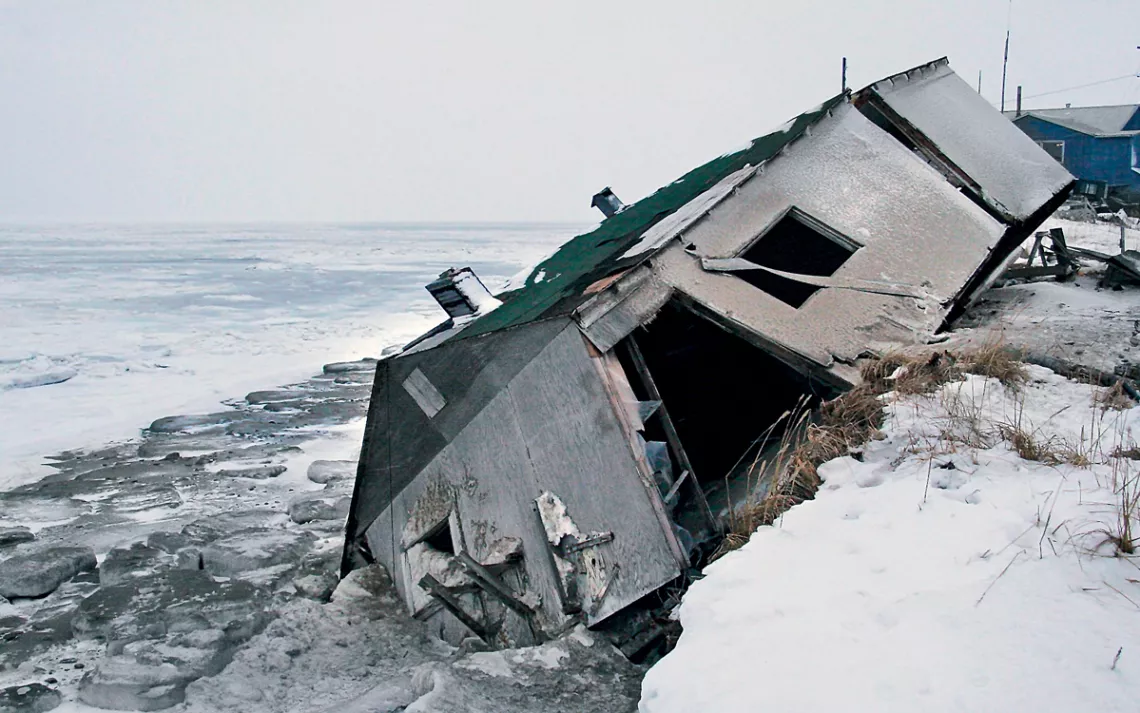
Nathan Weyiouanna's house slid onto the beach during a 2005 storm in Shishmaref, Alaska | Photo by Diana Haecker/AP Photo
The school is a single-story, rectangular building wrapped around a central gym, which also serves as a cafeteria and an auditorium for 200 K–12 students. It was end-of-the-year madness, and a steady stream of students, parents, and grandparents were coming through the office. An elder dropped off a flyer: Prom dresses on sale for $10 at the church. Someone came to pick up a sick child.
I learned from the principal's wife that a polar bear had wandered into town recently. It was spotted near the seal-drying racks, not far from some houses. A hunter chased it away and shot it. The bear was clearly a danger to the community, but it was also prized meat and fur in this hunting village. Weeks afterward, it was still the talk of the town. Everybody had pictures of the bear on their phones.
The previous night, at the Polar Cafe in Nome, a waitress had told me that polar bears can smell you 20 miles away—and will attack not only if threatened but also to eat you if they're hungry. For days after I arrived, I was uneasy walking around the village. Recent studies have shown that polar bears face increasing challenges hunting for seals in the sea and are beginning to spend more time on land in search of other food. With seasonal sea ice in the Arctic melting earlier and freezing later each year, hunting practices are shifting for people and wildlife alike.
Shishmaref's 600 residents rely largely on seals, walrus, birds, and caribou for their food supply, as the Inupiaq people of northern Alaska have done for millennia. As soon as the sea ice breaks up in the spring, Shishmaref hunters head out to the ocean on sleds drawn by snowmobiles to catch ugruk, or bearded seals, and later walrus. In summer and fall, residents cross the inlet-side lagoon on boats and head to the mainland tundra to stock up on berries and greens. This has been the way of life for generations of Shishmaref's kigiqtaamiut, or island people.
Long accustomed to living under the most extreme weather conditions, Inupiaq communities on Alaska's Arctic coast are facing their toughest challenge yet. The Arctic is warming twice as fast as the rest of the planet. Average air temperatures are more than 6°F warmer than they were at the beginning of the 20th century, and the lack of reflective snow is causing both land and sea to absorb more solar heat. The sea ice, critical to the creatures that sustain human life here, is melting. Sea ice also serves as a natural buffer, shielding coastal communities from the direct impact of storms. Recently, Shishmaref has been subject to stronger storm surges and increased flooding. A storm in 2013 eroded 50 feet of the beach overnight—including part of the road next to the airstrip, the only way out if the village should have to evacuate.
"THAT WAS A REAL BAD STORM," Tammy recalls. "The waves were all big. You could hear them and see them. Where I live, the lagoon was coming up pretty high toward our houses." Everybody was told to pack emergency bags in case they had to evacuate. "We all tried to stay awake just in case the waves were going to get bigger. Then it calmed down through the night," she says. "But it was scary 'cause that's our home, and it almost got taken away."
I'm sitting in a classroom with Tammy and her friend Nellie Eningowuk, 18, after school. Tammy is sewing a tote bag; Nellie, a kuspuk, a traditional Inupiaq shirt. Like American teenagers anywhere, they're dressed in jeans, hoodies, and sneakers, and they're listening to the latest hip-hop, rap, and pop songs while they sew. I ask the girls how they would describe life in their village.
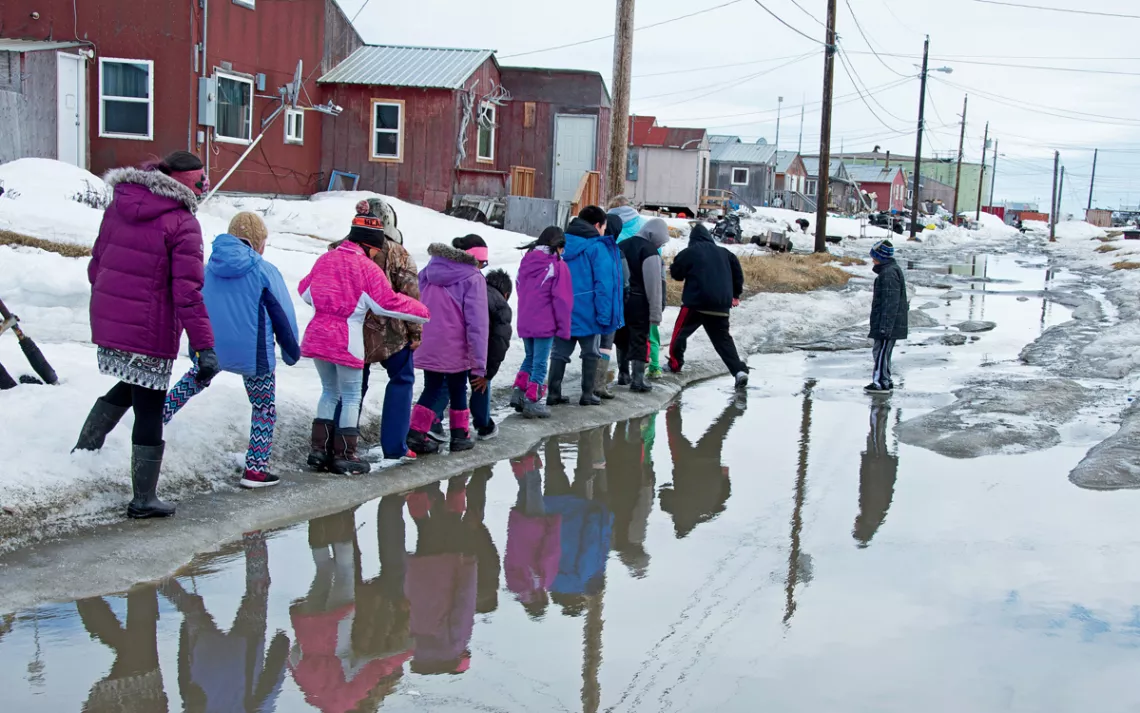
Dodging puddles during "breakup" (when the snows melt) in Shishmaref, Alaska | Photo by Rachel Rivera
"You could say we live in two-story igloos," Tammy deadpans. She shows me an essay she has written called "Life on the Edge," about how the waves are swallowing the island. "Erosion is what is happening to my hometown," it reads. "The storm surges cause the waves to rise and take our sand. The island has nothing but sand." When her ahna (grandma) was a young girl, she says, the beach used to be long and wide enough for airplanes to land on it. Today, it's just a narrow strip next to the houses. The airport sits farther inland, but she knows that it, too, will eventually get washed away.
"I think it was in elementary school that I realized our island was eroding," Nellie says. Her childhood memories are much like those I will hear from others around the village. "I remember there was an old playground on the beach. There used to be monkey bars and swings, slides and a teeter-totter, and a spinning thing. I remember playing over there with my sisters. And one day they weren't there anymore."
Warmer air temperatures are also thawing Alaska's underlying permafrost, accelerating shoreline erosion and washing away houses, roads, and other coastal infrastructure. Since 1969, Shishmaref has lost about 200 feet, according to an Alaska Department of Commerce report released in 2016.
I ask the kids at school what climate change means to them. "We're getting smaller," one replies.
AFTER A STORM IN 1997 washed away 30 feet overnight, Jonathan Weyiouanna, 51, led the crews that hoisted 14 houses from the most damaged stretch of beach onto skids and dragged them with a tractor farther inland. Today, a 1,500-foot-long wall of rocks and boulders along the north-facing shoreline barricades a row of oceanfront houses from the shrinking beach. "We'll have to see how this wall holds up," Weyiouanna says. Installed in several phases by the U.S. Army Corps of Engineers from 2004 to 2009, the wall was designed to provide protection for 10 to 15 years. Residents say that it has slowed erosion somewhat along that section of beach, but the shoreline continues to narrow along both the ocean and the lagoon sides of the island.
Weyiouanna points to the frozen sea on the other side of the wall. "We used to hunt way out there on the ice. The old guys used to go as far as 50 miles easy. Now we can go out only 15, maybe 20 miles," he says. "We used to go out on snow machines up until the middle of June. Now the ice starts breaking up in May. And it's all young, thin ice, dangerous to travel on. It doesn't freeze like it used to."
In 2007, Shishmaref lost its first hunter to the ice. "I remember that day like it happened yesterday," John Kokeok, 40, says of the early-June day he lost his youngest brother. "The ice melted sooner than usual, and his snow machine just fell through. His friend came back to get some rope, but when we went back to pull him out, he was already gone."
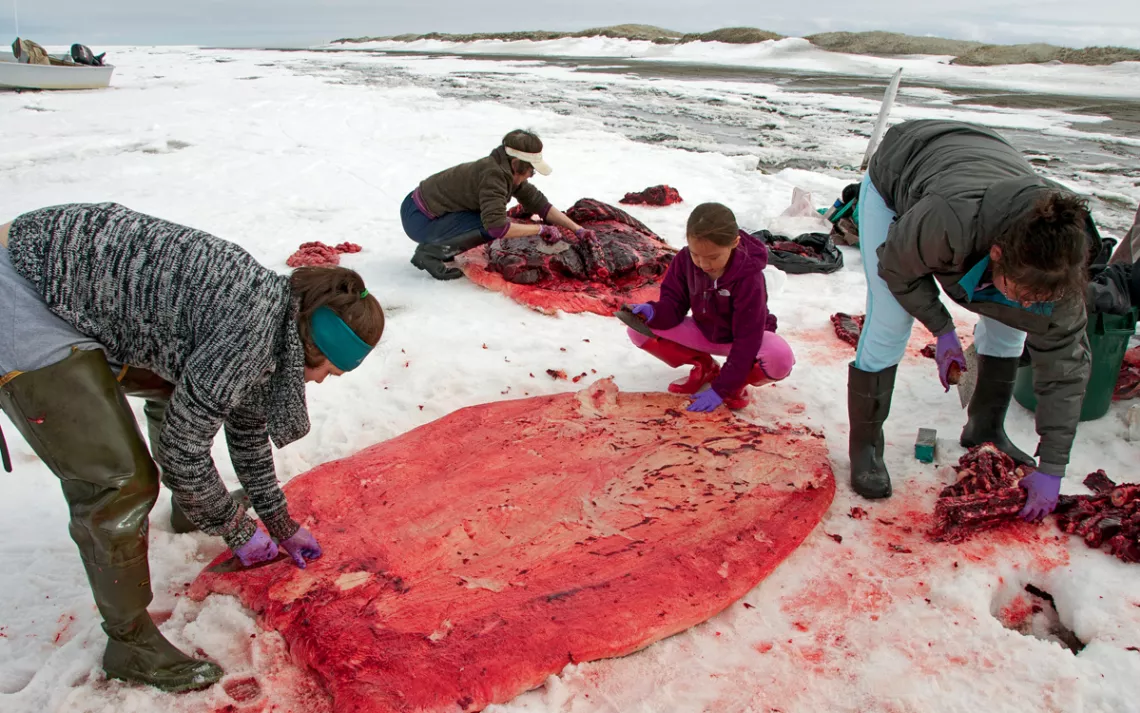
Shishmaref family cuts up an ugruk (bearded seal) | Photo by Rachel Rivera
The hunter's nephew, Esau Sinnok, 19, was nine years old at the time of the accident. Losing his uncle changed the course of his life. "My uncle was like a father to me, and climate change took his life," Esau says. "He's the biggest reason why I'm an activist today." One of 10 students in Shishmaref's class of 2016, Esau graduated a semester ahead of his classmates—"to begin my life's work," he says. In 2015, he joined a group of Arctic Youth Ambassadors to attend COP21, the UN climate change conference in Paris. "I went to tell world leaders about Shishmaref. We're on the front lines of climate change, and we need the world to know what's happening in my village."
After the conference, Esau enrolled at the University of Alaska, Fairbanks. I visited him near the end of his first semester. We met at the university's Rural Student Services, a support center for Alaska Native students, where that evening a group hosted a dinner featuring traditional foods. Over caribou soup, Esau talked about the challenges of studying far from his village. He was struggling with his math and economics courses, he said, and he was the only Native student in most of his classes. "Sure, I feel left out sometimes. I don't go to the dorm parties. It's not like home where you got your friends and your family, and everybody knows everybody," Esau said.
But Esau has his mind on the future. He plans to get a degree in tribal management so he can return to lead his village and rally support for the funding it needs to move to safer ground. "My community is my family. And if we have to move, we've got to move together," he said. "If we scatter, we'll lose who we are as a community. And Shishmaref will become just a memory. We can't let that happen."
Esau's mother, Bessi Sinnok, 50, teaches the bilingual-bicultural class at the Shishmaref school. "It's important that we teach the children the Inupiaq stories and traditions so they won't feel lost," she says. On the day I visit, Sinnok is showing students how to pluck and cut a ptarmigan to prepare the bird for cooking. It's ptarmigan-hunting season, and a student has come back with six birds. As she cuts up the ptarmigan, Sinnok shows her students all the bird's organs. "You can eat the lungs, the heart, the tail—there's a bite of meat down there—and the head. You eat the eyeballs and snap the skull open and eat the brain." I ask Sinnok when she learned how to dress a ptarmigan. "I learned to do this when I acquired my hunter," she says, a broad smile lighting up her face.

Make every day an Earth Day
Get articles like this one sent directly to your inbox.
With this action you affirm you want to receive Sierra Club communications and may vote on policy designated by the Sierra Club Board.
Boys in Shishmaref begin hunting early. "My grandpa and my uncle taught me how to hunt," says Sam Tocktoo, 18, one of Sinnok's students. "When I was seven, my grandpa gave me a gun, and I started practicing hunting birds with it." Sam recalls how his grandfather would take him along for the spring seal hunt. "I caught my first seal when I was like 10. I was with my grandpa and my brother. I saw a seal coming, and I got my gun ready. My grandpa taught me I should always have my gun ready whenever I see an animal. I killed that seal in one shot," Sam recalls, beaming. "When we kill our first animal, we have to give it to an elder. So I put the seal on a sled and brought it to my great-aunt Elizabeth that night. She smiled and thanked me, and I felt very accomplished."

Tammy Iyatunguk and her grandmother Nora Kuzuguk at Tammy's high school graduation in Shishmaref. | Photo by Rachel Rivera
Outside, the ice has begun to thaw, the roads awash in puddles. "Breakup," they call it here. When the ice starts to melt and gives way to open water, it signals the start of seal-hunting season. It's Saturday morning, and everybody is out shopping for groceries and hauling water from the washateria, where people do laundry, take showers, and fill up large garbage bins of water for the next week.
I'm dodging puddles and the occasional animal part peeking out of the snow—seal claws, some intestines, a half-eaten carcass of something—when a voice calls out from one of the houses: "Hi. What's your name?'' An old woman is sitting on her doorstep, a friendly face wrapped in a red bandanna. I stop to chat. She tells me she's Nora Kuzuguk, 69, born and raised in Shishmaref. She's a mother of 10 children and has about 40 grandchildren and 12 or 15 great-grandchildren. "I've lost count," she says, laughing. Everyone you meet in the village is related to somebody else you've met, and it turns out Kuzuguk is Tammy's ahna.
Kuzuguk recounts stories about the big beach where the airplanes used to land and where they played all day, the same games the kids still play today: Eskimo baseball and izhiga (like hide-and-seek but with boundaries).
"And then the water came in," Kuzuguk says. Her house is among those perched on a bluff buttressed by a wall of rocks. "In a big storm, the water sometimes splashes over the seawall to our houses," she says. "I guess we'll have to move someday." I ask her how that makes her feel. "Sad," she answers, then looks away, falling silent.
IN 2002, SHISHMAREF RESIDENTS voted to move the village to the mainland, which would have made them among the world's first climate refugees. But the effort lost momentum after years of lobbying state and federal agencies failed to yield the funds to cover the high cost of moving. The Army Corps of Engineers has estimated that relocating would cost upward of $180 million. Attempts to find a viable location to build a new village hit a dead end after a site selected on the mainland was found to be sitting on thawing permafrost.
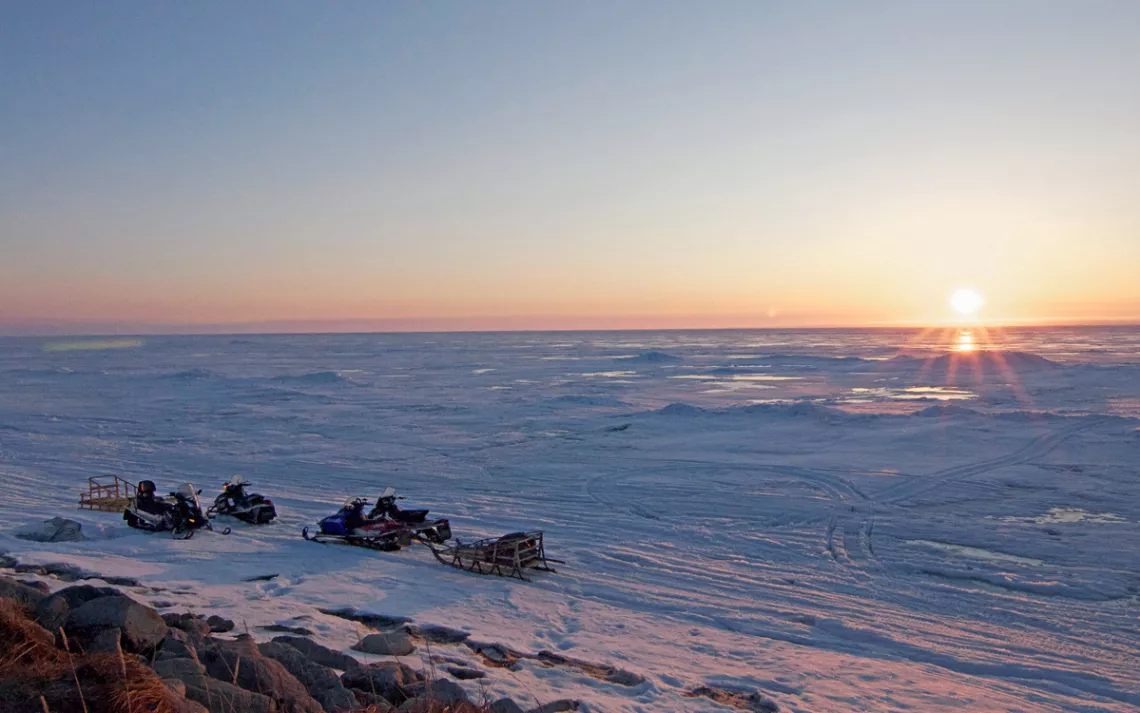
Snowmobiles have replaced dogsleds as the main mode of transport in this Alaskan Arctic village. | Photo by Rachel Rivera
After years of inaction, Shishmaref voted again, in August 2016, to relocate to one of two other sites on the mainland. But until state or federal funds can be found to rebuild the village, the vote is unlikely to mean a move anytime soon. "We're waiting to hear if there will be funding from anybody," says Annie Weyiouanna, Shishmaref's relocation coordinator. "The state is doing budget cuts all over. And we haven't heard anything from the federal government about support or funding for us to relocate." In the meantime, she says, more studies are needed to determine whether the two sites under consideration are environmentally suitable.
Shishmaref is not alone in its predicament. There are 31 other Alaska Native villages in "imminent danger" because of erosion and flooding, according to a 2009 report from the U.S. Government Accountability Office. But state funds traditionally available to Alaska's rural communities are targeted toward economic and infrastructure development, explains Sally Russell Cox, a community planner for the Alaska Division of Community and Regional Affairs.
"We don't have funding established for relocation," Cox says. "Why there are no funding streams is a good question. We have a real responsibility to Shishmaref. But these are very small communities of just several hundred people, and population is a big factor in cost-benefit analyses when weighing what's a feasible investment for the government."
In September 2015, following President Barack Obama's visit to Alaska, the White House designated the Denali Commission, a small federal economic-development agency in Anchorage, to coordinate federal funding to assist Alaska's climate-threatened communities, including support for relocation. "We were given authority to lead these efforts, but that didn't come with a budget," says Chris Allard, program manager for the commission. President Donald Trump's proposed federal budget eliminates the Denali Commission entirely—as well as the Essential Air Service, which makes Shishmaref's flights to the mainland possible.
At the Shishmaref city office, community planner Fred D. Eningowuk is reviewing the feasibility study of the relocation sites. He is not impressed. "If we have to move to the mainland, how will I get down here to hunt ugruk in the spring?" he asks. "We're one of the last communities in the world that still does this. From the mainland, it will cost too much for us to get to the ocean. We'll be stuck on the mainland, and that will change who we are."
At 59, Eningowuk, like other older residents of Shishmaref, is reluctant to start over. "I grew up here. This is where I was born and raised," he says. "I think we can save Shishmaref. We're Eskimos. We're a very strong people. We've been adapting here for eons."
ON ONE END OF THE BEACH, some women have gathered. Hunters have just returned with the first three ugruk of the spring hunt. A family—mother, daughter, and grandmother—is cutting up one of the seals. "Each family hopes to catch three to six seals to supply meat and seal oil for the year," says Donna Barr, 41. "But it all depends on ice conditions. The weather's always the boss."
The women slice off the blubber, cut off the flippers and the head, and then detach the ribs. "We'll cook some of the fresh meat tonight and hang the rest to dry and eat throughout the year," Barr explains. "The head is the only part we don't eat, though the elders like to ferment the whiskers and eat them with seal oil." The blubber is cut into strips and stored in a bucket, then left to render for the oil to seep out. Oil made from rendered seal blubber is a Shishmaref delicacy, used as a major ingredient in Inupiaq foods, and is traded with other Native villages in the region. "Everybody in Alaska says seal oil from Shishmaref is the best," Barr says.
THE DAY AFTER GRADUATION, I visit Tammy at her house on the lagoon side of the island. We go on a walk, and I ask her about her plans for the future. "The erosion has gone too far already," she tells me. "If the village moves, I know we'd have to adjust to living on the mainland, but I'd be happy to move. I would feel relieved just knowing we don't have to worry about being underwater." She and her high school sweetheart, Perry, want to move to Nome, she adds, as soon as she can raise the money for her airfare: "I want to have running water. I want to have a job."
A few nights later, Tammy wins $500 at bingo—the biggest prize of the night, enough to cover her ticket out of town. She and Perry catch the first flight to Nome the following morning. They leave before I can say goodbye.
A week later, I get a text message from Tammy: "im very homesick for shish."
This article appeared in the July/August 2017 edition with the headline "Life on the Edge."
 The Magazine of The Sierra Club
The Magazine of The Sierra Club

